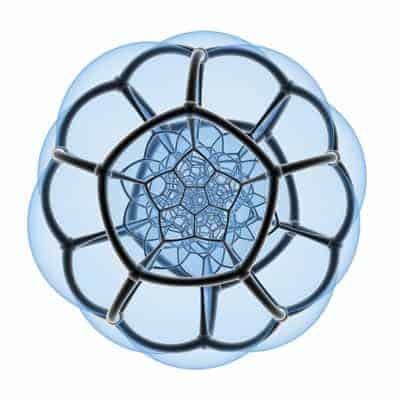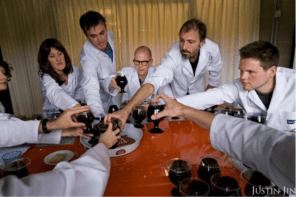Despite being the daughter of a mathematical genius, Alicia Boole Stott received no formal education and grew up in Dickensian poverty. Robert P Crease explains how she still developed a uniquely imaginative mathematical mind

She is unlikely to be someone that many physicists will have heard of. But Alicia Boole Stott (1860–1940) was one of the first people to explore 4D geometrical figures and had a remarkable ability to conceive how such figures are put together, despite being essentially self-educated. Her path to a mathematics career, however, was full of sorrow, indirection and drama.
Stott’s life might have served as plot material for a Victorian novel. Her father, George Boole, was the son of a cobbler who could only meagrely provide for his family. Yet George managed to become a professor of mathematics at Queen’s College, Cork, win the Royal Society’s gold medal and create the field of mathematical logic — as in “Boolean algebra” — all without having a university degree. When George died in 1864, he was not yet 50, his third daughter Alicia was not yet four, and his wife Mary was pregnant with their fifth child Ethel.
Boole’s death left his wife Mary — the niece of Sir George Everest, after whom the famous mountain was named — and her five daughters Mary Ellen, Margaret, Alicia, Lucy, and Ethel in dire poverty. Mary sold the Royal Society’s gold medal and went to work as a matron at Queen’s College in London. With little time for her own children, she left the middle child, Alicia, with an uncle in Cork. Alicia spent a few lonely and unhappy years there before joining her mother.
Life of surprises
Adding to the family’s misfortunes, Mary was by then an invalid. Alicia and her four sisters had little or no schooling and shared a single, filthy bedroom. Their life became more burdened when their mother befriended an eccentric surgeon and author called James Hinton. According to the mathematician Harold “Donald” Coxeter, Alicia’s later collaborator, Hinton brought to the house “a continual stream of cranks”. These oddballs hung out in the single sitting room and “talked endlessly about subjects that Alice, Lucy and Ethel were too young to understand but not too young to brood over”.
When Alicia was about 16, she went back to Cork to work in a children’s hospital for a short time. When she returned to London, she met James Hinton’s son Charles “Howard” Hinton (1853–1907), a mathematician, teacher and science-fiction writer who was as eccentric as his father but more appealing. The younger Hinton was one of the first to be convinced of the real, rather than merely formal, existence of a fourth spatial dimension, and even emphasized its educational value. He coined words to name its features (such as “tesseract” for a 4D hypercube), composed exercises to develop the ability to imagine it, and recruited the three youngest Boole sisters to help him build models to represent 4D figures known as hypersolids.
Howard Hinton never lost his flair. He married the eldest Boole sister Mary Ellen, was arrested for bigamy (she was not his only wife), and spent a day in jail for the charge before fleeing with Mary Ellen to Japan. Later, he spent a few years at Princeton University, where his achievements included inventing a gunpowder-driven pitching machine for baseball practice, which caused several injuries to players. After he was expelled from Princeton, he moved to Minnesota and Washington, DC before his death in 1907.
Working in 4D
But three decades earlier, before leaving London, Hinton had sparked in Alicia, then at the end of her teenage years, a mathematical imagination. Entranced, she built models of “regular” hypersolids — i.e. those in which every face is the same. In three dimensions, as the ancient Greeks first pointed out, there are five regular polyhedra: tetrahedron, cube, octahedron, dodecahedron and icosahedron. In four dimensions, however, there are six. Just as each regular polyhedron has square, triangular or pentagonal faces, each of the 4D hypersolids has tetrahedra, cubes, octahedra or dodecahedra as its 3D “faces”. Alicia now invented a word of her own — polytope — to refer to a geometrical figure in n dimensions.
Alicia married an actuary, Walter Stott, in 1890. Then came another lucky coincidence. Walter noticed a paper, written by a Dutch mathematician called Pieter Schoute from the University of Groningen, about the same 4D figures. Alicia sent Schoute pictures of her models; the two met and began collaborating. They were “an ideal team”, Coxeter remarks, for “her power of geometric visualization supplemented Schoute’s more orthodox methods of using coordinates”.
Schoute helped Alicia to transform her amateur diversion into a professional pursuit by helping her to publish papers under her own name that outlined discoveries connected with 4D figures. These works, plus her models, strongly contributed to making four dimensions real rather than merely formal. Some 4D figures have even turned out to have physics applications: a recent paper (arXiv:physics/0601139v1) shows that the 24-cell and the 600-cell occur as minimum-energy configurations of charged particles on the 3-sphere.
Some of Alicia’s models are on display at Groningen and at the Faulkes Institute for Geometry at Cambridge University. In a recent article for the American Mathematical Society about Alicia’s 120-cell hypersolid, my colleague Anthony Phillips describes how he photocopied the templates in her article, then coloured and assembled the figures, each one a “face” of a 4D hypersolid.
The critical point
Alicia Boole Stott’s story is a time-honoured one, exemplifying the power of the human imagination to thrive under adverse conditions. She was fortunate to have enough prowess in mathematics to allow her to explore, understand and innovate in an area that did not require mastery of a body of mathematical theorems. She was also fortunate, after such a despondent childhood, in retaining the interest and energy to do so.
But her story is also disturbing in the extent to which these depended so much on luck and circumstance. One goal of any rational science education should be to make sure that fertile imaginations such as hers succeed not by sheer chance, but within a framework that nurtures and protects them.



